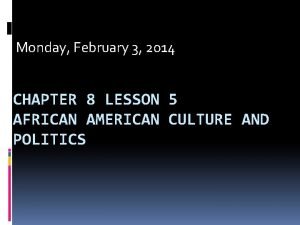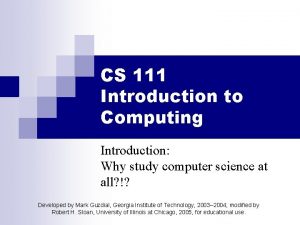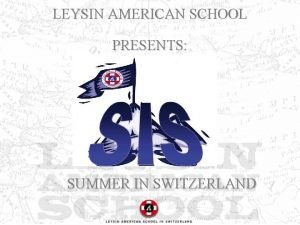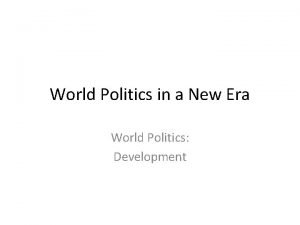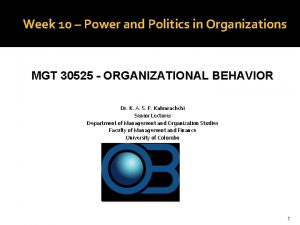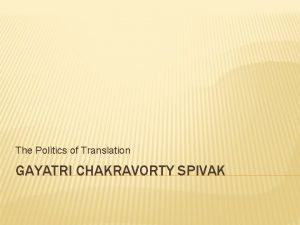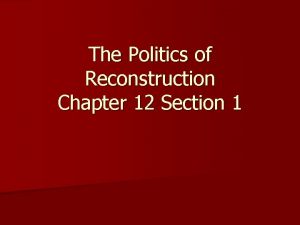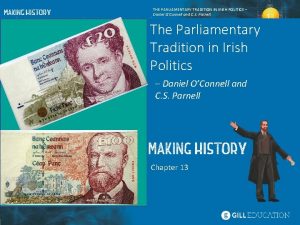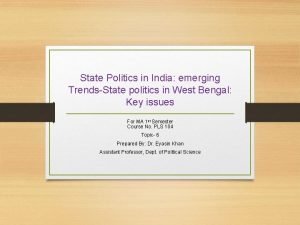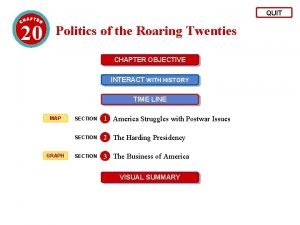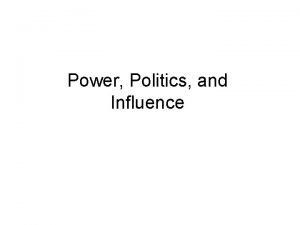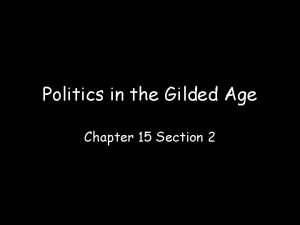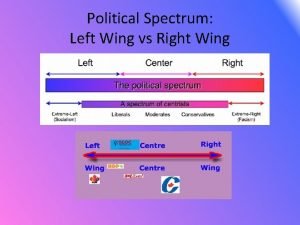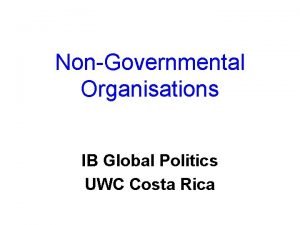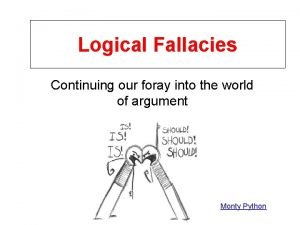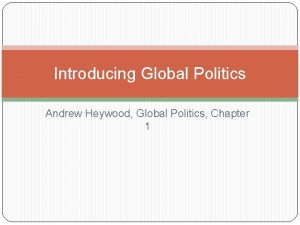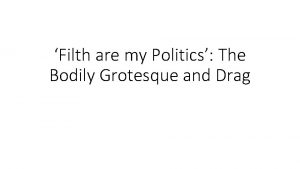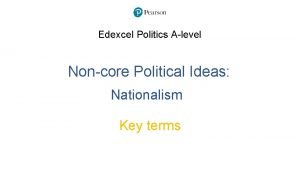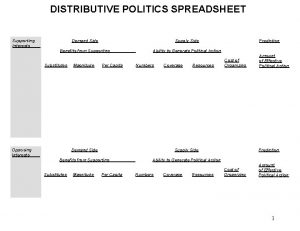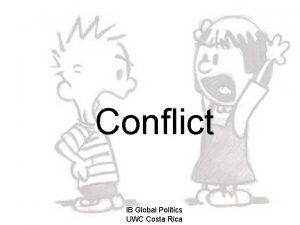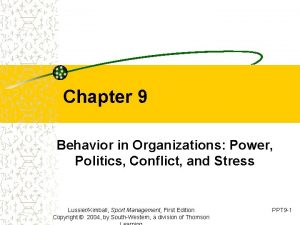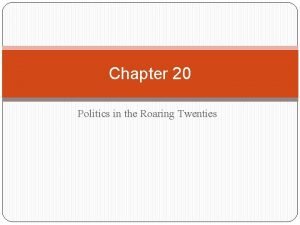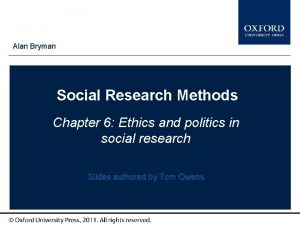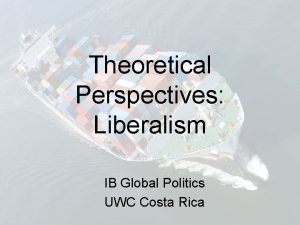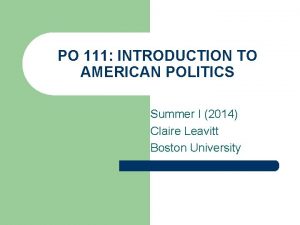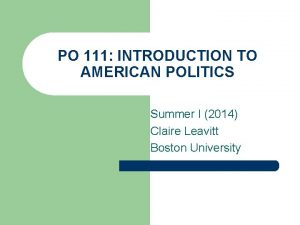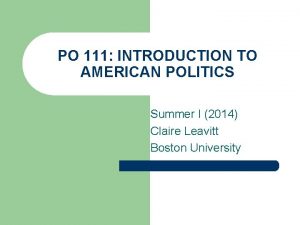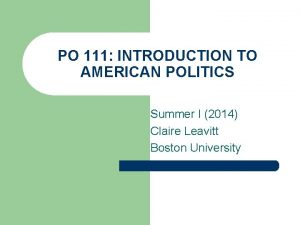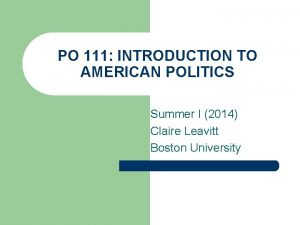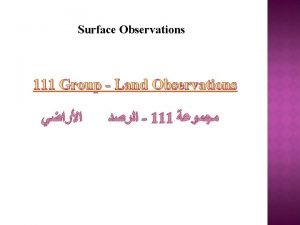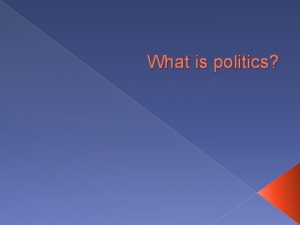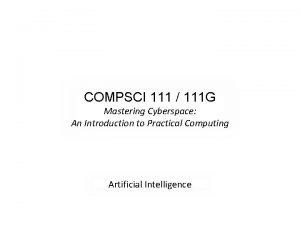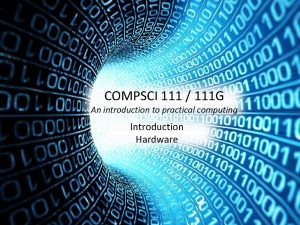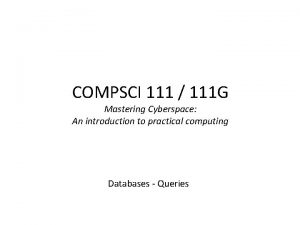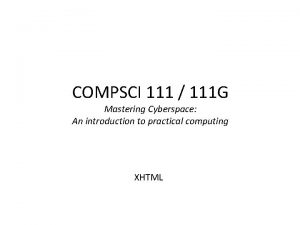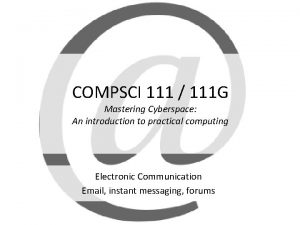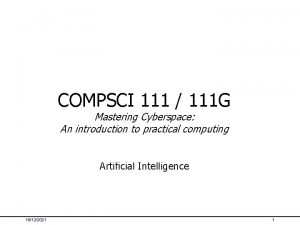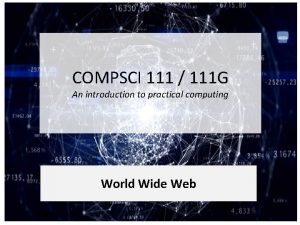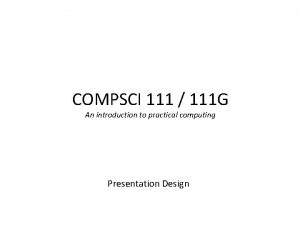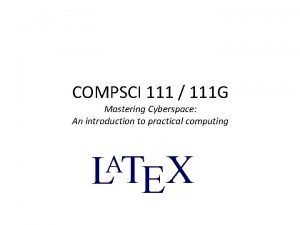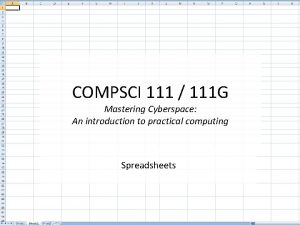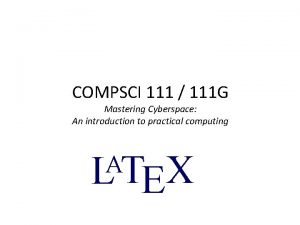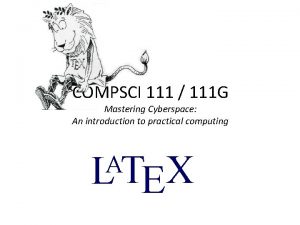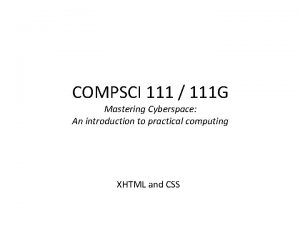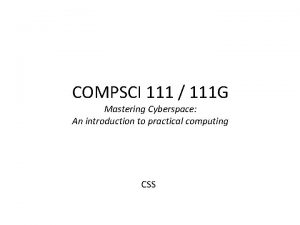PO 111 INTRODUCTION TO AMERICAN POLITICS Summer I





























- Slides: 29

PO 111: INTRODUCTION TO AMERICAN POLITICS Summer I (2014) Claire Leavitt Boston University

TABLE OF CONTENTS • The Basics: Executive Powers • The 19 th Century Presidency • The Modern Presidency: Augmentations of Presidential Power – Executive Orders – Veto Bargaining – Institutionalization of the Executive – Legislative Agenda-Setting • Bargaining, Leadership and “Going Public”

PRESIDENTIAL AUTHORITY UNDER ARTICLE II 1) To command the military Check: Only Congress can declare war 2) To appoint judges, foreign ambassadors and cabinet officers Check: A majority of the Senate must approve the president’s choices

PRESIDENTIAL AUTHORITY UNDER ARTICLE II 3) To oversee operation of all executive agencies Check: Only Congress may regulate (number, jurisdictions) of executive agencies 4) To make treaties with foreign nations Check: 2/3 of the Senate must approve these treaties

PRESIDENTIAL AUTHORITY UNDER ARTICLE II 5) To appoint officers to fill government vacancies when the Senate is in recess Check: The Senate may overturn these appointments once they come back 6) To veto Congressional legislation Check: Congress may override the president’s veto by a 2/3 vote

PRESIDENTIAL AUTHORITY UNDER ARTICLE II 7) To inform Congress on the state of the union 8) To pardon anybody who has been convicted of a federal crime Check: None

PRESIDENTIAL AUTHORITY UNDER ARTICLE II 9) To “take care that the laws be faithfully executed”: To carry out the laws made by Congress To meet with foreign representatives on behalf of the United States To direct/command government officers and staff To convene special sessions of Congress

THE CONSTITUTIONAL DEBATE US executive modeled after the British monarchy Hamilton insisted that while the role of the American executive resembles that of Great Britain, in fact the president’s powers are far more limited The executive was intentionally established as the weakest branch of US government

PRESIDENT VERSUS MONARCH AMERICAN PRESIDENT BRITISH KING Elected every four years Hereditary appointment for life May be tried, impeached and removed from office for high crimes and misdemeanors Is above the law; cannot be removed from officer save for revolution Possesses negative power (the veto) that may be overridden by Congress Possesses absolute negative power May direct military actions; but only Congress can declare war and raise a national army Can command the military, declare war and raise national armies May enter into treaties with foreign nations, provided 2/3 of the Senate agrees Possesses sole power to enter into or dissolve treaties with foreign nations May appoint officers to agencies created by Congress May create agencies and appoint officers to those agencies Presides over a nation with no established religion Head of the Church of England

THE CONSTITUTIONAL DEBATE Hamilton’s Vision for an “Energetic” Presidency: • Unity – Plurality suits legislatures; but deliberation and dissention impedes the effectiveness of an executive • Secrecy (transparency will impede the president’s ability to swiftly execute the law, esp. in the name of national security • Sufficient—but not monarchical—power • Electoral college will ensure president is virtuous and wise; reduce probability of anarchy

THE FIRST HUNDRED YEARS • Presidential power exercised in foreign affairs and in governmental appointments • Cabinet officers were most powerful appointment opportunities; also commanded great deal of political autonomy • Presidents bargained with cabinet officers and Congress without a guarantee of leadership

THE FIRST HUNDRED YEARS • Presidents largely associated with and dependent upon their party – Direct primary elections not instituted until turn of the 20 th century – State-controlled ballots not introduced until 1880 s

THE FIRST HUNDRED YEARS 1789 -1832: Leading by Reputation Presidents stood apart from special interests and parties; they governed according to the strength of their personal reputations among political elites 1832 -1900: The Partisan Era The beginning of what Lincoln called a “clerkship”; president concerned mainly with doling out patronage appointments and party favors

THE FIRST HUNDRED YEARS Did Presidents Lead? : • Neustadt: Pre-modern presidents could be leaders; they did not have to be • Yet almost all 19 th-century presidents are on the record as claiming they want to stand apart, to make history, to make the office their own • Almost all were hindered by constitutional limitations

THE FIRST HUNDRED YEARS Did Presidents Lead? : • Neustadt: Pre-modern presidents could be leaders; they did not have to be • Yet almost all 19 th-century presidents are on the record as claiming they want to stand apart, to make history, to make the office their own • Almost all were hindered by constitutional limitations

THE MODERN PRESIDENCY What accounts for the growth in presidential power? • Congress willingly ceded more powers to the president • New interpretation of the “take care” clause as justification for a more powerful president

THE MODERN PRESIDENCY: POWERS Executive Orders: • Directives/instructions issued by the president for a government agency to take a specific action • Have the force of law • Positive power • Difficult to be overturned by Congress

THE MODERN PRESIDENCY Executive Orders: Strategic Bargaining Divided Government Gridlock Interval Space for EO United Government Gridlock Interval Space for EO Median voter Liberal Filibuster voter Vetooverride voter Conservative

THE MODERN PRESIDENCY Executive Orders: • But there are political costs to executive orders • The public and other political institutions tolerate more direct presidential action now than it did in the nineteenth century; political norms have changed

THE MODERN PRESIDENCY The Veto: • Negative power • The veto is effective as a silent threat • Veto bargaining is a strategic game between the president and Congress – Who will suffer the political consequences of the veto most often?

THE MODERN PRESIDENCY Other presidential powers: • Institutionalization of the White House – Office of Management and Budget – National Security Council – Council of Economic Advisors • Agenda-setting power – Annual budget process – External crises

THE MODERN PRESIDENCY Neustadt and Presidential Bargaining: • Bargaining is the power to persuade other political actors to implement your preferences • Bargaining is the pith of presidential power; the answer to why the presidency is simultaneously the weakest and strongest branch of government

THE MODERN PRESIDENCY Neustadt and Presidential Bargaining: • Bargaining is conditional, its effectiveness dependent upon the president’s: – Popular support – Institutional support – Flexibility/time – Ability to make careful choices – Ability to spend political capital wisely

THE MODERN PRESIDENCY When Presidential Bargaining Fails: • Why was Truman unable to bargain with Mac. Arthur? • Why did Eisenhower choose not to bargain with Governor Faubus? • Is Neustadt’s argument non-falsifiable? • Is Neustadt’s argument still relevant?

THE MODERN PRESIDENCY When Presidential Bargaining Fails: • Why was Truman unable to bargain with Mac. Arthur? • Why did Eisenhower choose not to bargain with Governor Faubus? • Is Neustadt’s argument non-falsifiable? • Is Neustadt’s argument still relevant?

THE MODERN PRESIDENCY Going Public: The president’s increasing his bargaining position with Congress by making a case for a policy, campaign-style, directly to the American people • Leverages public opinion to supplement the president’s bargaining position • Increases under divided government • Has increased as the system has changed from one with a few power players to one with multiple power players

THE MODERN PRESIDENCY Downsides to Going Public? • Over-saturation • Oversimplification of substantive issues • Stoking of resentment in Congress • De-legitimization of Congress’s lawmaking authority • Possibility of backfiring, provoking counterattacks • Possibility of failure; wasted political capital

THE MODERN PRESIDENCY Does Going Public Work? • Does it actually change legislative outcomes? • Greatest power of “going public” is the president’s ability to increase the salience of a policy issue • When that issue becomes salient, members of Congress will assess public opinion and act accordingly • Public opinion does not always go the president’s way

THE MODERN PRESIDENCY • What kind of president is Barack Obama? – Is he ambitious? – Does he put a high premium on bargaining? – Does he utilize “going public”? – Is he a Hamiltonian?
 110 000 110 111 000 111
110 000 110 111 000 111 Lesson 5 african american culture and politics
Lesson 5 african american culture and politics It 111 introduction to computing
It 111 introduction to computing Leysin summer school
Leysin summer school World politics in a new era
World politics in a new era Power and politics in organizations
Power and politics in organizations The politics of translation spivak summary
The politics of translation spivak summary Chapter 12 section 1 the politics of reconstruction
Chapter 12 section 1 the politics of reconstruction Catholic tradition
Catholic tradition Explain emerging patterns of state politics in india
Explain emerging patterns of state politics in india Politics of the roaring twenties
Politics of the roaring twenties A key part of backstabbing as a political tactic is to
A key part of backstabbing as a political tactic is to Factors contributing to organizational politics
Factors contributing to organizational politics Chapter 15 section 3 politics in the gilded age
Chapter 15 section 3 politics in the gilded age Right wing meaning
Right wing meaning Political power
Political power Opportunities and challenges in media and information essay
Opportunities and challenges in media and information essay Uwc global politics
Uwc global politics Bureaucracy and politics in india
Bureaucracy and politics in india Logical fallacy meaning
Logical fallacy meaning Heywood global politics
Heywood global politics Filth is my politics
Filth is my politics Nationalism edexcel politics
Nationalism edexcel politics A level politics comparative theories
A level politics comparative theories Distributive politics spreadsheet
Distributive politics spreadsheet Ib global politics costa rica
Ib global politics costa rica Power politics and conflict in organizations
Power politics and conflict in organizations Chapter 20 politics of the roaring twenties
Chapter 20 politics of the roaring twenties Ethics and politics in social research bryman
Ethics and politics in social research bryman Uwc global politics
Uwc global politics

